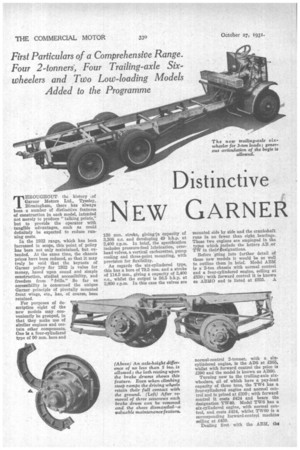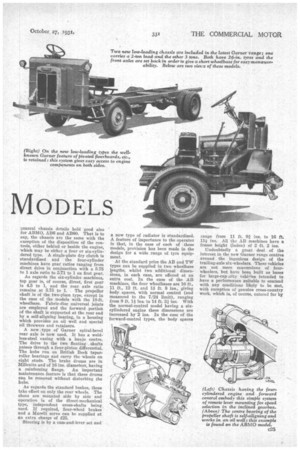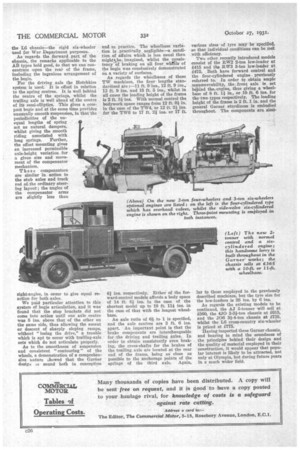Distinctive
Page 74

Page 75

Page 76

If you've noticed an error in this article please click here to report it so we can fix it.
NEW GARNER MODELS
First Particulars of a Comprehensive Range.
Four 2-tormers, Four Trailing-axle Six wheelers and Two Low-loading Models Added to the Programme
THROUGHOUT the history of Garner Motors Ltd., Tyseley, Birmingham, there has always been a number of distinctive features of construction in each model, intended not merely to produce "talking points," but to provide the operator with tangible advantages, such as could definitely be expected to reduce running costs.
In the 1932 range, which has been Increased in scope, this point of policy has been not only maintained, but extended. At the same time, the chassis prices have been reduced, so that it may truly be said that the keynote of Garner policy for 1932 is value for money, based upon sound and simple construction, studied accessibility, and freedom from "frills!' So far as accessibility is concerned the unique Garner principle of pivotally mounted front wings, etc., has, of course, been retained.
For purposes of description eight of the new models may conveniently be grouped, in that they make use of similar engines and certain other components. One is a four-cylindered type of 90 mm. bore and 130 mm, stroke, giving 'a capacity of 3,308 c.c, and developing 49 b.h.p. at 2,400 r.p.m. In brief, the specification includes pressure-feed lubrication, overhead valves, a vertical carburetter, pump cooling and three-point mounting, with provision for flexibility.
As regards the six-cylindered type, this has a bore of 79.5 mm. and a stroke of 114.5 tam., giving a capacity of 3,400 c.c., whilst the output is 56.5 b.h.p. at 2,600 r.p.m. In this ease the valves are mounted side by side and the crankshaft runs in no fewer than eight bearings. These two engines are employed in the types which include the letters AB or TW in theirlilesignations.
Before -going into further detail of these new models it would be as well to outline them in brief. Model ABM is a 2-ton chassis with normal control and a four-cylindered engine, selling at £330; with forward control it is known as ABM° and is listed at 1355. A
normal-control 2-tonner, with a sixcylindered engine, is the ABB at 1365. whilst with forward control the price is £390 and the model is known as AB60.
Turning now to the trailing-axle sixwheelers, all of which have a pay-load capacity of three tons, the TW4 has a four-cylindered engine and normal control and is priced at 1399; with forward control it costs 1424 and bears the designation TWO. Model TW6 has a six-cylindered engine, with normal control, and costs 1434, whilst Thr60 is a corresponding forward-control machine selling at /459. Dealing first with the ABM, tini
general chassis details hold good also for ABMO, AB6 and AB60. That is to say, the chassis are the same with the exception of the disposition of the controls, either behind or beside the engine, which may be either a four or six-cylindered type. A single-plate dry clutch is standardized and the four-cylinder machines have gear ratios ranging from direct drive in conjunction with a 5.75 to 1 axle ratio to 5.71 to 1 on first gear.
As regards the six-cylinder machines, top gear is, of course, direct, first gear is 4.5 to 1, and the roar, axle ratio remains at 5.75 to 1. The propeller shaft is of the two-piece type, except in the case of the models with the 10-ft. wheelbase. Fabric-disc universal joints are employed and the forward portion of the shaft is supported at the rear end by a self-aligning bearing, in a housing which provides an oil well and special oil throwers and retainers.
A new type of Garner spiral-bevel rear axle is now used. It has a weldless-steel casing with a banjo centre. The drive to the two floating . shafts paSses through a four-pinion differential. The hubs run on British Bock taperroller bearings and carry the wheels on eight studs. The brake drums are in Millenite and of 16 ins, diameters, having a reinforcing flange. An important maintenance feature is that these drums can be removed without disturbing the hubs.
As regards the standard bnakes, these take effect on only the rear wheels. The shoes are mounted side by side and operation is of the direct-mechanical type, independent cross-shafts being used. If required, four-wheel brakes and a Marelli servo can be supplied at an extra charge of £25.
Steering is by a cam-and-lever set and
a new type of radiator is standardized. A feature of importance to the operator is that, in the case of each of these models, provision has been made in the design for a wide range of tyre equipment.
At the standard price the AB and TW types can be supplied in two wheelbase lengths, whilst two additional dimensions, in each case, are offered at an extra cost. In the case of the AB machines, the four wheelhases are 10 ft., 11 ft., 12 ft. and 13 ft. 8 ins., giving body spaces, with normal control (and measured to the 7/24 limit), ranging from 9 ft. 14 ins. to 14 ft. 31 ins. With the normal-control model having a sixcylindered engine these dimensions are increased by 2 ins. In the case of the forward-control types, the body spaces range from 11 ft. 91 ins. to 16 ft. 111 ins. All the AB machines have a frame height (laden) of 2 ft. 2 ins.
Undoubtedly a great deal of the interest in the new Garner range centres around the ingenious design of the trailing-axle six-wheelers. These vehicles are not mere conversions of fourwheelers, but have been built as bases for large-caw.city vehicles intended to have a performance suitable to contend with any conditions likely to be met, with exception of genuine cross-country work, which is, of course, catered for by
the L6 chassis—the rigid six-wheeler used for War Department purposes.
As regards the forward part of the chassis,, the remarks applicable to the A.11 types hold good, so that we can concentrate -upon the rear of the frame, including the ingenious arrangement of the bogie.
For the driving axle the Hotchkiss system is used.' It is offset in relation to the spring centres. It is well behind the centre of the springs, whilst the trailing axle is well ahead of the centre of its semi-elliptics. This gives a compact bogie and at the same time provides unusually smooth suspension, in that'the periodicities of the unequal lengths of spring act as natural dampers whilst giving the smooth riding associated with long springs. Further, the offset mounting gives an increased permissible axle-height variation for a given size and movement of the compensator mechanism.
These compensators are similar in action to the stub axles and track rod of the ordinary steering layout ; the angles of the compensator arms are slightly less than right-augles, in order to give equal reaction for both axles.
We paid particular attention to this system of bogie articulation, and it was found that the stop brackets did not come into action until One axle centre was 5 ins, above that of the other on the same side, thus allowing the ascent or descent of sharply sloping ramps, without "losing the drive," a trouble which is apt to occur with trailing-axle sets which do not articulate properly.
As to the smoothness of suspension and consistent " contouring " of the wheels, a demonstration of a comprehensive nature :lowed that the Garner desig:. es sound both in conception and In practice. The wheelbase variation is praetileilly, negligible—a condition of affairs which is less usual than mightkbe. imagined, whilst the consistency of braking on all four whrels of the bogie was conclusively demonstrated On a variety of surfaces.
As regards the wh6elbases of these TW machines, the four lengths standardized are :-11 ft. 9 ins., 12 ft. 9 ins., 13 ft. 9 ins. and 15 ft. 5 ins., whilst in all cases the loading height of the frame is 2 ft. n ins. With normal control the bodywork space ranges from 12 ft. Oi in. in the case of the TW4, or 12 ft 21 ins. for the TWO to 17 ft. 21 ins. or 17 ft.
41 ins, respectively. Either of the forward-control models affords a body space of 14 ft. 8i ins, in the case of the shortest model up to 19 ft. 111 ins, in the case of that with the longest wheelbase.
An axle ratio of si to 1 is specified, and the axle centres are 3 ft. 6 ins. apart. An important point is that the brake components are interchangeable for the driving and trailing axles. In order to obtain consistently even braking, the cross-shafts for the brakes of the trailing axle are located at the rear end of the frame, being as close as possible to the anchorage points of the springs of the third axle. Again,
various sizes of tyre may be specified, so that individual conditions can be met with efficiency.
Two other recently introduced models consist trf the RW2 2-ton low-loader at £415 and the RW3 3-ton low-loader at £475. Both have forward control and the four-cylindered engine previously referred to. In order te obtain ample manceuvrability, the•.front axle is set behind the.engine, thus giving a wheelbase of 8 ft. 11 in., or 10 ft. 6 ins, for the two types respectively. The loading height of the frame is 2 ft. 1 in. and the general Garner sturdiness is embodied throughout. The components are Bind
lar to those employed in the previously described machines, but the tyre size for the low-loaders is 25 ins. by 6 ins.
As regards the existing models to be continued, the AJ 3-tonner will sell at £560, the 4J0 3-31-ton chassis at £615, and the J06 31-4-ton chassis at £735, whilst the L6 cross-country six-wheeler is priced at £775.
Having inspected these Garner chassis, and bearing in mind the soundness of the principles behind their design and the quality of material employed in their construction, it would appear that popular interest is likely to be attracted, not only at Olympia, but during future years in a much wider field.




































































































































































